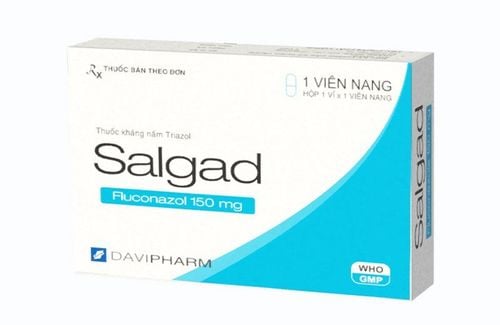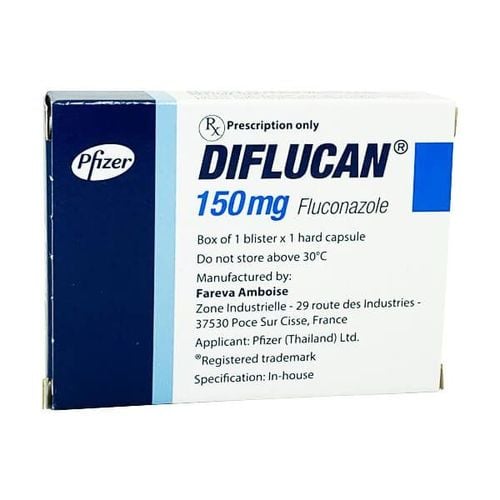This is an automatically translated article.
Flucoted belongs to the group of antifungal drugs, containing the main ingredient is Fluconazole, effective in treating Cryptococcus meningitis. However, the drug also has some side effects that users need to be aware of for timely treatment.
1. What does Flucoted do?
Flucoted contains the main ingredient Fluconazole, which belongs to the Triazol group with peripheral or systemic antifungal effects, especially on Candida. The mechanism of action of fluconazole is a selective inhibition of cytochrome P450 sterol C14 alpha-dimethyl in fungi. As a result, it changes the permeability of the fungal cell membrane, releases essential substances (amino acids, potassium, ...) and reduces the absorption of precursor molecules such as Purin, Pyrimidine. The subsequent loss of normal sterols correlates with the accumulation of C14 alpha-methyl sterols in the fungus and may respond to the fungicidal activity of fluconazole.
Fluconazole is effective against most strains of Candida, including end-stage fungal infections in AIDS patients who are resistant to other antifungal agents such as Nystatin, Ketoconazole and Clotrimazol. Therefore, the drug Flucoted is usually indicated in the following cases:
Candidiasis in the vagina and vulva; Oral, esophageal, urinary tract, peritoneal and other serious systemic candidiasis; Meningitis caused by Cryptococcus neoformans; Fungal diseases caused by Blastomyces, Coccidioides immitis and Histoplasma; Prophylaxis of recurrent candidiasis in patients with persistent leukopenia. Contraindications of Flucoted include:
Patients with hypersensitivity to Azol-class antifungal agents or any component of Flucoted; Concomitant use of Terfenadine is contraindicated in patients receiving repeated doses of fluconazole 400 mg/day or higher; Concomitant use of Flucoted with drugs that prolong the QT interval and are metabolized by the enzyme CYP3A4 is contraindicated; Acute porphyria metabolism disorder.
2. Dosage of Flucoted
Depending on the fungus causing disease and kidney function as well as the patient's response to treatment, the dose of Flucoted will be different:
For infants:
In the first 2 weeks after birth: dose 3 - 6mg/kg/time every 72 hours From 2nd to 4th week postpartum: use dose 3 - 6mg/kg/time at least 48 hours For children:
Treatment dose: 6mg/kg/day and have up to 12mg/kg/24 hours in 2 divided doses in cases of persistent disease. Do not exceed 600 mg per day Prophylactic dose: 3mg/kg/day for superficial fungal infections Systemic fungal infections: 6-12mg/kg/day For adults with candidiasis:
Vulva-vaginal: single dose 150mg/time/day, if necessary to prevent relapse, 1 more dose can be used in 4-12 months; Oropharyngeal: 150mg/time/day is recommended for 1-2 weeks; In the esophagus: 150mg/time/day for at least 3 consecutive weeks and 2 more months after symptom resolution; Systemic fungal infections: 3 tablets of 450 mg on the first day, then 150 mg once a day for at least 4 weeks and another 2 weeks after the symptoms are gone. For adults with cryptococcal encephalitis:
First day take 450mg/time; The following days, 150-450mg/time/day for at least 6-8 weeks after CSF culture results are negative; For HIV-infected patients, to avoid relapse, Difuzit should be used at a dose of 1 tablet once a day for a long time. For other subjects:
Prophylaxis of fungal infections in bone marrow transplant recipients: 450mg/time/day is recommended; In patients with severe agranulocytosis, prophylactic fluconazole should be started a few days before neutropenia and continued for 7 days after the neutrophil count exceeds 1000/mm3. Patients with renal failure with vulvovaginal candidiasis do not need to adjust the dose when using Flucoted for treatment; Patients with renal impairment with creatinine clearance less than 50 ml/min requiring multiple doses of fluconazole should be titrated to 50% of the usual dose.
3. Flucoted side effects
In some patients when using Flucoted, side effects may occur such as:
Nervous: Headache, dizziness; Digestive disorders, nausea, diarrhea; Slight increase in serum transaminases and bilirubin; Rash, itching; Scaly skin (mainly in AIDS and cancer patients; Steven-Johnson syndrome; Fever, edema, pleural effusion; anaphylactic shock; oligouria, hypotension).
4. Precautions when using Flucoted:
Some general notes when using Flucoted drug include:
Caution when using Flucoted in patients with impaired liver and kidney function, arrhythmia or prolongation of the QT interval on the electrocardiogram; Fluconazole should be used during pregnancy only when the potential benefit outweighs the risk to the fetus; Fluconazole is excreted in milk at concentrations similar to those in plasma, so it is contraindicated in lactating women; Flucoted medicine has the potential to cause unwanted effects such as headache, dizziness, so be careful when driving and operating machinery.
5. Drug interactions with Flucoted
Flucoted drug can increase the plasma concentration of antidiabetic drugs of the Sulfonylurea group, Phenytoin , Theophylline, Astemizol, anticoagulants of the Coumarin group and antivirals; Concomitant administration of fluconazole and rifampicin may affect the pharmacokinetics of both drugs, in which fluconazole is reduced in absorption and half-life; Fluconazole increases the plasma concentration and AUC of rifabutin in HIV patients; Concomitant administration of zidovudine and fluconazole interferes with the metabolism and clearance of zidovudine. Above is information about uses, dosage and precautions when using Flucoted. To ensure safety for your health and maximize the effectiveness of your treatment, you need to take Flucoted exactly as directed by your doctor.
Please dial HOTLINE for more information or register for an appointment HERE. Download MyVinmec app to make appointments faster and to manage your bookings easily.













